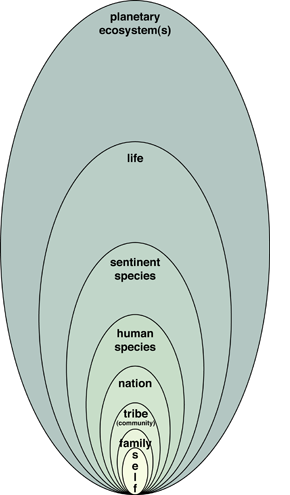 The golden rule admonishes treating others as one would like to be treated.
The golden rule admonishes treating others as one would like to be treated.
But which others?
We tend to draw distinctions in our identifications with others, relations with others, or concerns for others. Distinctions like family or not family, human or not human.
In this diagram, I visualize common distinctions as spheres of relation or concern, and think of the delineation — from self to ecosystem — as an identity tree.
What would your identity tree look like?
Thanks for the conversations: Peter+Trudy Johnson-Lenz


Thanks for sharing and asking, and generally what you do.
Mine begins with the intrapersonal, acknowledging relations in the classic self: body, mind, heart & spirit. Then the interpersonal, like the ones shown, including the partner(s), family/team, and tribe/community scales. Superimposed on that one is interspecies, particularly those species visiting and living in the home bioregion. All in a sphere representing the bioregion’s abiotic dynamisms: the rhythms, elements and gravity.
I stop there, because I advocate relocalization.
I like the extent of the nested ellipses, and David’s relational and abiotic aspects. For me, the self BEGINS relationally – the melding of two cells. The idea of first self, then other seems a little backward. Babies take a few months to recognize that they are themSelves, not their Others.
The importance of the relational aspect shows up in the work of Daniel Siegel in the study of interpersonal neurobiology (see http://www.amazon.com/Pocket-Guide-Interpersonal-Neurobiology-Integrative/dp/039370713X) He conceives of mind as a relational process ( a VERB) co-created by the interaction of:
the brain + our relationships + our emerging mind.
This excerpt from an interview about mindfulness practices says it better than I can:
“Part of the reflective practice, ironically, is that it makes our
senses stronger and bodily well-being clearer, and increases empathy towards others, which then strengthens our connections to people in our lives. We become more open in a loving and wonderfully exciting new way. In fact the real definition of self becomes we, and all of a sudden we begin to think that there is hope for the planet. We begin to realize this is our collective home. There is real hope to turn things around. I am incredibly optimistic that with reflective practices there is hope for our species. We have to understand the brain so that we can grasp how non-integrated thinking puts us at risk for planetary destruction, but also to harness the power of our creativity to turn it all around and turn this into a much more integrated home in which we live. When we understand how our social networks interconnect in that intimate way, we realize the potential is huge. The ultimate outcome of integration is compassion. When we talk about integration within the context of personal health, we are also talking about implications for cultural evolution. In that way, health becomes a secular essence that all people have a right to receive, and we can all work to bring that healthy state of integration to the world.”